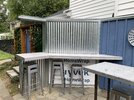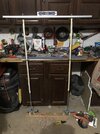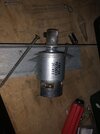I am building an outdoor pub in my backyard. Included will be a TV that i would like to keep behind a moveable panel when not in use. I've purchased two 12v drill motors that will each turn a linear actuator at each end of the moveable panel. (panel weight 10 LB).
image 0628 shows the panel in the up position.
image 3231 shows my mock up
image 3232 shows the drill motor
I'm using 12 g twisted copper wire to connect the motors in parallel to a 12V 16 W drill battery to test out if this set up will work. Wire length is no more that 6' for the longest run
Wires get very hot
I want to get a transformer to replace the drill battery but the two i have purchased are 6V max. Also the terminals for the on hand transformers are not large enough to accept a 12 g wire.
What is going wrong? I appreciate any direction GEC can provide. Thank you
Joe
image 0628 shows the panel in the up position.
image 3231 shows my mock up
image 3232 shows the drill motor
I'm using 12 g twisted copper wire to connect the motors in parallel to a 12V 16 W drill battery to test out if this set up will work. Wire length is no more that 6' for the longest run
Wires get very hot
I want to get a transformer to replace the drill battery but the two i have purchased are 6V max. Also the terminals for the on hand transformers are not large enough to accept a 12 g wire.
What is going wrong? I appreciate any direction GEC can provide. Thank you
Joe



